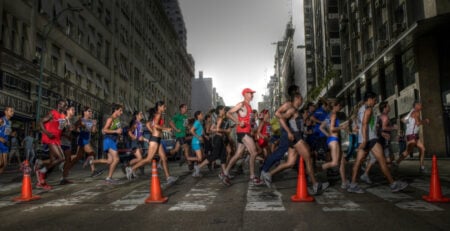Fartlek Running Part 3
In this, the final in our series of quality sessions for running, we complete the set with some more race-specific sessions, which will train us both physically and mentally to peak for our goal race.
Session Seven – Changing gear
Still a fartlek session but now we are mixing up the length of the efforts because, in a real race situation, things are rarely uniform and we are constantly required to change gear.
To begin with, the warm up – As before, this should be more than just a light jog to loosen up the muscles. You want to end your warm up period at optimum operating temperature. You need to be ready to lift the pace comfortably when you are done. So start nice and easy but gradually increase the effort as your body warms up. Rule of thumb would be starting at around 65-70% of maximum HR and end the warm up period at around 85%. 10-15 minutes will be sufficient because we don’t want to be fatigued before we start the main set of our session.
For this session we are going to run intervals of 1:00; 2:00 and 3:00 with only a 1:00 floating recovery period in between each. We are going to run three sets and change the order of the intervals in each set.
So the order will be:
1:00; 2:00; 3:00
2:00; 3:00; 1:00
3:00; 1:00; 2:00
We do this continuously, so there are no gaps between sets and the standard recovery period of 1:00 applies no matter what the length of the preceding or following interval.
The idea is to change the pace according to the length of the interval. This way we are never able to settle into a steady rhythm and we are constantly placing demands on our muscles and cardio-vascular system.
There are a number of ways that you can alter the session to change the demands. You can change the length of the three intervals in the set, or add another set starting from 1:00 again. All depending on your level of condition and the event that you are training for.
REMEMBER: TRAINING SHOULD ALWAYS BE RELEVANT TO THE EVENT THAT YOU ARE TRAINING FOR!
Always have a decent warm down period after running at intensities like this. Again 10-15:00 and this should be done opposite to the warm up. Gradually go easier and easier and you can even end off with a few meters of walking.
A good stretch afterwards will also help with your recovery and be good for maintaining your flexibility and range of motion in your joints.
Session Eight: Tempo Session
To a lot of runners the tempo session may mean simply running at a set pace, close to race pace, for an extended period of time. Now that is certainly one way to do it but these efforts can often become race level efforts and we must bear in mind that we only have a limited number of those in a season. So let us rather save those for when there is someone to witness our pace and a medal and a results list at the end.
This time we will look at a tempo run that is aimed at a longer race. We will use a half marathon as the goal for this one but you can adjust the distances and pace for whatever your goal race distance.
REMEMBER: Training must be relevant and specific to be most effective.
For a 21.1km we need to be able to finish strong and be able to maintain good form even though our legs are fatiguing. This session will be aimed at someone who is running a 1:30-1:45 half marathon.
To start we want to ease ourselves into the run and allow the legs to loosen up a bit from the training that you may have done in the preceding days. So a nice relaxed jog building into a moderate pace so that your HR rises to around 70% of your maximum after about 10:00.
Then, for the next hour you want to lift your pace and run at a nice steady but not half marathon race pace. Probably around :15 per kilometre slower than your projected half marathon race pace. This pace should not require too much concentration as you will be running comfortably and within yourself but faster than an easy, recovery effort.
At the end of the hour, slow gradually and walk for a minute or so to allow your HR to drop below 60%. Then do 10 X 200m repetitions at your projected half marathon race pace. There is no need to go faster and this should feel pretty comfortable over such a short distance. You want to focus on holding great form and focus on your body position. Have 100m walking and then 100m jogging as a recovery period.
Then finish off your run with another 10:00 of easy running to cool down.
VARIATION:
This is a nice session to do from your local gym. End the hour steady period back at the health club and stride through and onto a treadmill for the 200s. Run with an elevation of 1-2% and then set the pace slightly faster than your 21.1km pace because the treadmill accelerates more gradually than we do on the road.
This session is more enhanced if you can see yourself in the mirror on the treadmill. Then you will be able to keep an eye on your posture and form while performing the intervals.
Session Nine: The negative split run
This is a fun session that is a tempo effort that will teach pacing and strong finishing. There are numerous options to this as far as distance and pace variation goes. So depending on your current condition and goal race distance, be creative.
The warm up for this run can be shorter than the fartlek sessions that we have covered as the first stretch of the run should be at an easier pace. So just a few minutes of jogging to ease out any residual stiffness from the previous session and you are good to go.
We will use a session of an hour as an example. This session is easier to do on a flatter route so that the pacing is made easier. To increase the challenge you can do it on an undulating track but try to ensure that the ups and downs are pretty uniform for the first and second halves.
This is an ‘out-and-back’ session. These are usually tough mentally and adding in the negative split goal will give you something to concentrate on and make things more interesting.
The idea is simple. Run out at a comfortable pace resulting in a heart rate around the 75% of maximum range. This should be a controlled and relaxed pace but harder than your recovery pace. For the hour session, keep running until you hit the 32:00 mark and then turn and aim to get back in 60:00. Resulting in a 28:00 return leg and a considerably harder effort.
You can vary things like your initial pace going out and when you turn to increase the challenge. A nice negative split session, if you have a suitable route, is to run out for 30:00 (using the hour run again) on a course that is gently downhill all the way. Then turn and try to get back in 30:00 as well but obviously running uphill coming back.
Always keep track of your progress so that you can gauge whether you will need to increase your pace to get back in time. It is always a good idea to build your effort so that you get faster and faster as the finish approaches. You want to avoid starting too hard after the turn and then blowing before the end.
As you will end the hour period running hard, you definitely want to spend a few minutes jogging easy to cool down and even finish off with a minute or two of walking before you hit the showers.
Session Ten: The pre-race run
It is most common for runners and triathletes to rest the day before the event. This can be counter-productive in that the muscles tighten up and we can often feel sluggish the next day at our goal event when we want to be sharp and ready to go. The best way to rest and recover for an event is to rest two days out, take it easy and stay off your feet as much as possible and have a gentle but thorough stretch in the morning and evening, preferably after a hot bath or shower so that the muscles are warm.
Then, on the morning before the race, it is always better to go for a light session. Start out easy and relaxed and gradually allow you muscles to ease into the run and shake off the sluggishness that may have developed after the rest day. For this sluggishness to have occurred is logical when we consider that the body has become used to training on a daily basis as we have built up to this event.
Run for 10-20 minutes nice and easy, which should quite naturally, speed up as the body warms and loosens up. Once you are moving smoothly and comfortably add in 4-5 accelerations of 30 seconds. These are not intervals and should be nice and gradual and each one should end slightly faster than the one before. The last one should reach your projected race speed.
End off with a few more minutes of easy running and gradually and steadily slowing down until you end off walking for the last few hundred meters.
Then, take it easy for the rest of the day and you will be good to go!






Leave a Reply